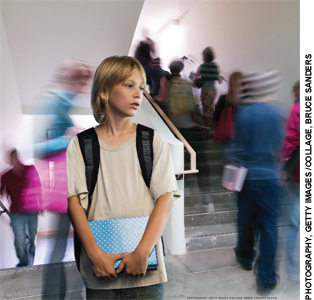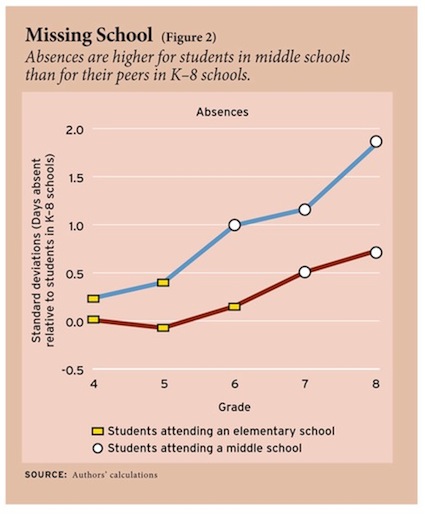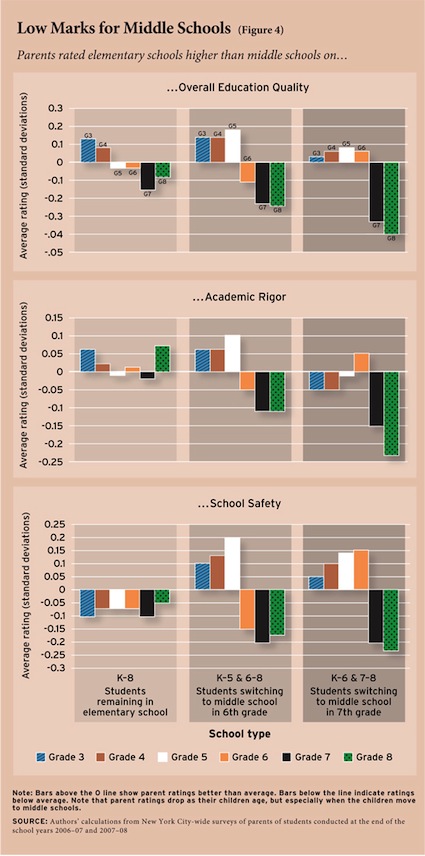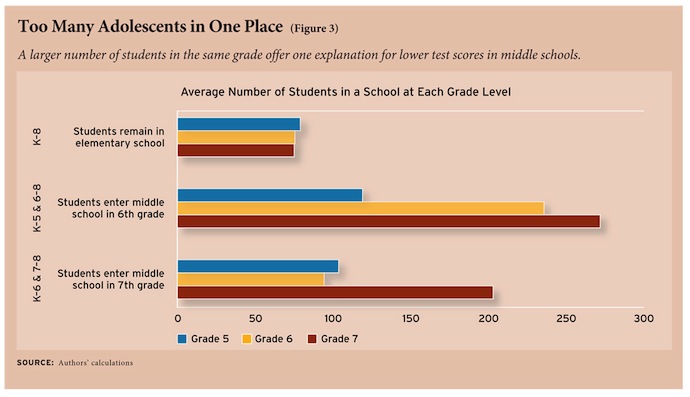An unabridged version of this article is available here.

Middle school. The very words are enough to make many Americans shudder with memories of social anxiety, peer pressure, bad haircuts, and acne. But could middle schools also be bad for student learning? Could something as simple as changing the grade configuration of schools improve academic outcomes? That’s what some educators have come to believe.
States and school districts across the country are reevaluating the practice of educating young adolescents in stand-alone middle schools, which typically span grades 6 through 8 or 5 through 8, rather than keeping them in K–8 schools. The middle-school model began to be widely adopted almost 40 years ago. Now, reformers in Massachusetts, Pennsylvania, Ohio, Tennessee, Oklahoma, Maryland, and New York, and the large urban districts of Cincinnati, Cleveland, Philadelphia, and Baltimore, are challenging the notion that grouping students in the middle grades in their own school buildings is the right approach.
Why the turn against middle schools? For more than three decades, American public education embraced this organizational model. Between 1970 and 2000, the number of public middle schools in the U.S. grew more than sevenfold, from just over 1,500 to 11,500. These new middle schools displaced both traditional K–8 primary schools and junior high schools (which first appeared a century ago and served grades 7–8 or 7–9). From 1987 to 2007, the percentage of public-school 6th graders in K–6 schools fell from roughly 45 percent to 20 percent.
Neither the middle school nor the junior high has ever been popular among private schools, which educated only 2 percent of their 6th and 7th graders in these types of schools in 2007. And maybe the private schools have had it right all along. For the last two decades, education researchers and developmental psychologists have been documenting changes in attitudes and motivation as children enter adolescence, changes that some hypothesize are exacerbated by middle-school curricula and practices.
These findings are cause for concern, but there is reason to doubt their conclusions. Because the studies use data from a single school year to contrast students in middle schools and K–8 schools, most of the available research cannot reject the possibility that differences between the groups of students, rather than in the grade configuration of their schools, are actually responsible for the differences in behavior and achievement.
To provide more rigorous evidence on the effect of middle schools on student achievement, we turned to a richly detailed administrative dataset from New York City that allowed us to follow students from grade 3 through grade 8. Some of these children attended middle schools and some did not. Because we could follow the same children over a period of time, we could do a better job of ruling out the role of influences other than middle-school attendance on educational outcomes.
What we found bolsters the case for middle-school reform: in the specific year when students move to a middle school (or to a junior high), their academic achievement, as measured by standardized tests, falls substantially in both math and English relative to that of their counterparts who continue to attend a K–8 elementary school. What’s more, their achievement continues to decline throughout middle school. This negative effect persists at least through 8th grade, the highest grade for which we could obtain test scores.
We found that the middle-school achievement gap cannot be explained by a scarcity of financial resources for the schools. Instead, the cause is more likely to be related to other school characteristics, especially the fact that middle schools in New York City educate far more students in each grade. Although our conclusions about the reasons for the middle-school gap are tentative, we are quite confident that the evidence shows that middle schools are not the best way to educate students—at least in places like New York City.
Data and Methods
Our study was based on data for New York City school children who were in grades 3 though 8 during the 1998–99 through 2007–08 school years. We were able to follow students who entered 3rd grade between the fall of 1998 and the fall of 2002 for six years, until most had completed the 8th grade. We have data about the grade configuration and other characteristics of their schools, individual academic achievement as measured by annual standardized test scores in math and English, and a variety of personal characteristics. In particular, we know each student’s gender, ethnicity, whether they received free or reduced-price lunch through the federal lunch program, whether they were English language learners or received special education services, and their record of suspensions and absences from school.
Elementary schools in New York City typically serve students until grade 5 or grade 6, while a smaller portion of elementary schools run through grade 8. This means that most students move to a middle school in either grade 6 or grade 7, while some never move to a middle school. Of the 3rd graders in our initial sample of students, 62 percent were in a K–5 school, 24 percent were in a K–6 school, and 7 percent were enrolled in a K–8 school. The small fraction of remaining students attended K–3, K–4, or K–7 schools and are excluded from our analysis.
To isolate the impact of attending a middle school from the many other factors that influence student achievement, we combined two basic strategies. Most importantly, we tracked the performance of individual students over time to see how their performance evolved relative to that of their peers as they progressed from grades 3 to 8, in essence, using each student as his or her own control group. This step alone provides much stronger grounds for conclusions about the effects of attending a middle school than previous research.
A lingering concern, however, is the possibility that different types of students choose to attend middle schools than choose to continue in a K–8 school. If students do sort themselves into middle schools because of some unobserved characteristic that causes changes in academic achievement over time, we would incorrectly attribute differences in achievement to the middle schools instead of to characteristics of the students themselves. We reduced the likelihood of making this mistake by using a statistical technique that effectively takes the choice to switch schools out of the students’ (or parents’) hands. Specifically, we ran a statistical model that used the last grade served by the school that a student attended in grade 3 to predict whether the student attended a middle school. We then used that prediction to place each student into one of the two groups we are comparing, that is, students who attend middle schools and those who do not. Our key assumption in taking this approach is that there are no unobservable factors that cause a drop in student achievement at precisely the same time as students must leave the elementary schools they attended in grade 3. While we cannot definitively rule out the existence of such factors, we do not know of any plausible alternatives that would explain our findings.
The Middle-School Disadvantage
What determines a student’s level of academic achievement is complex. But the simple fact is that students who enter public middle schools in New York City fall behind their peers in K–8 schools. This is true both for math and English achievement. Even more troubling, the middle-school disadvantage grows larger over the course of the middle-school years. With the transition into a middle school, students set out on a trajectory of lower achievement gains.
The achievement gap between middle-school students and K–8 students is put in stark relief in Figure 1, which displays our estimates of the impact of attending a middle school on student achievement as measured by standardized tests in math and English Language Arts. The graphs show how well students who attend a middle school perform relative to how we would expect them to perform if they attended a K–8 school. We report those differences, in standard deviations of student achievement in math and reading, for the 3rd through 8th grades. We separate students who enter a middle school in grade 6 from those students who enter a year later, in grade 7.
No matter whether students enter a middle school in the 6th or the 7th grade, middle-school students experience, on average, a large initial drop in their test scores. Even after accounting for a host of other factors that influence student achievement, students who eventually attend middle schools go from scoring better than their counterparts in K–8 schools in the year prior to transitioning to middle school to scoring below where we would expect if they were not attending a middle school. Math achievement for 6th graders transitioning to middle school falls by 0.18 standard deviations, and English achievement falls by 0.16 standard deviations. Contrast that decline with the 6th-grade test scores for students who will enter middle school the following year, in the 7th grade. Their test scores in both subjects continue to improve relative to their peers in K–8 schools. When these 6th graders move to a middle school in the 7th grade, however, we see the same dramatic fall in academic achievement: math scores decline by 0.17 standard deviations and English achievement falls by 0.14 standard deviations. Just how large are these effects? Consider that decrease in achievement associated with middle school entry—between 0.14 and 0.18 standard deviations—is roughly 20 to 25 percent of the achievement gap between poor and non-poor students (as measured by free lunch receipt) in New York City (about 0.7 standard deviations).
Moreover, these are not temporary dips followed by rebounds in learning. Throughout the middle-school years, students fall further behind. After two years in a middle school, on average a student who entered in the 7th grade will score 0.10 standard deviations in math and 0.09 standard deviations in English below what we would expect if he had gone to a K–8 school. After three years in a middle school, a student who entered in the 6th grade will underperform on 8th-grade assessments by 0.17 standard deviations in math and by 0.14 standard deviations in English.
A particularly distressing finding from our study is that students with lower initial levels of academic achievement fare especially poorly in middle school. To investigate the possibility of different effects on students with higher and lower initial achievement levels, we separated students into two groups: one group had grade 3 test scores above the citywide median, the other group scored below the median. Although we found substantial drops in achievement during middle school for both groups of students, the first-year drop and cumulative deficit were, respectively, 50 percent and more than 200 percent greater for students who start at the lower end of the achievement distribution.
 We also found evidence that student absence rates increased when students entered middle schools and were significantly higher in grade 8 than for students who never entered a middle school (see Figure 2). More specifically, our estimates indicate that students were missing almost two additional days of school per year than would have been the case had they attended a K–8 school. Thus, increased absences may be one mechanism through which middle schools lower student achievement. There is little chance, however, that absences could explain a large share of the overall effect of attending a middle school.
We also found evidence that student absence rates increased when students entered middle schools and were significantly higher in grade 8 than for students who never entered a middle school (see Figure 2). More specifically, our estimates indicate that students were missing almost two additional days of school per year than would have been the case had they attended a K–8 school. Thus, increased absences may be one mechanism through which middle schools lower student achievement. There is little chance, however, that absences could explain a large share of the overall effect of attending a middle school.
To be sure, the population of public school children in New York City is different from that of many other school districts around the country. These differences might mean that middle-school attendance would have smaller or larger effects on other students than we estimate it to have on New York City’s public school children. For example, students with fewer educational resources at home may be more strongly affected by changes in their school environment. If that is the case, studying New York City students, who arguably come from less advantaged backgrounds than, say, the students in New York City suburbs, may have led us to find a larger middle-school effect than had we followed a more-affluent student population. While we encourage readers to be cautious about applying our findings without qualification to all public schools, we also encourage school districts to support research that can identify middle-school effects in other settings, especially since we find the consequences of attending a middle school for student achievement to be substantial and troubling.
Explaining the Trouble with Middle Schools
Why might New York City’s middle schools be detrimental to academic achievement? We find little support for the notion that differences in resources, such as per-pupil expenditures and class size, could explain the middle-school achievement gap. In middle schools serving grades 6–8 and grades 7–8, average per-pupil expenditures were $10,094 and $11,082, respectively, while per-pupil expenditures in K–8 schools were roughly equivalent, at $10,950. Nor do students experience a large decline in per-pupil spending when they move to a middle school. Average per-pupil expenditure in K–5 schools was $10,144 (compared to the $10,094 for grade 6–8 middle schools) and $9,680 in K–6 schools (compared to $11,082 in grade 7–8 middle schools).
Nor can we attribute the disparity we see to differences in class size. The average class size is slightly smaller for 5th graders in K–5 schools than for 6th graders in 6–8 schools (24 vs. 25 students); students in K–8 schools see similar growth in class size between grades 5 and 6. Class size is actually larger for grade 6 students in K–6 schools than for grade 7 students in 7–8 schools (24 vs. 23 students).
What about the possibility that the relative age of students in a school, especially during adolescence, can influence how students learn? In other words, does being the youngest students in a school have negative effects on the educational experience of those students? We could not find evidence in our data to support this explanation for the initial drop in test scores upon transitioning to a middle school. In our study sample, about one-third of new 7th graders moved out of a school serving grades K–6 and entered a middle school for 7th and 8th graders, becoming the youngest cohort in the school, while roughly half of new 7th graders entered a grade 6–8 middle school as part of the school’s middle cohort of students. We find that the effect of entering a middle school was essentially the same for both of these groups.
At least part of the problem with middle schools may be that they usually combine students from multiple elementary schools. In the New York City schools we studied, the average cohort size was 75 students in K–8 schools, 100 students in K–5 and K–6 schools, and over 200 students in middle schools for grades 6–8 and 7–8 (see Figure 3). We went back to our data and analyzed the effect of these cohort size differences on test scores. What we found was that cohort size has a pronounced influence on student achievement during these school years. We estimate that an 8th grader who attends school with 200 other 8th-grade students will score 0.04 standard deviations lower in both math and English than he would if he attended a school with 75 other 8th graders, the average cohort size for a K–8 school. This 0.04 standard deviation deficit represents roughly one-quarter of the largest test-score declines we attribute to middle-school attendance.
Given the data we have, we can only speculate about why it is harder to educate middle school–aged students in large groups. Developmental psychologists have shown that adolescent children commonly exhibit traits such as negativity, low self-esteem, and an inability to judge the risks and consequences of their actions, which may make them especially difficult to educate in large groups. The combining of multiple elementary schools and their students also disrupts a student’s immediate peer group. And middle schools often serve a more diverse student population than many students encountered in elementary school. Yet while it seems plausible that these changes in environment would matter, we could not find any evidence in our data that any one hypothesis can explain the drop in learning among students moving to middle schools.
Even though a full explanation of the middle-school achievement gap eludes us, there does seem to be a consensus among New York City students and their parents that educational quality in the city’s public middle schools is lower than in the boroughs’ K–8 schools. We reached this conclusion after examining responses to a citywide survey of parents of children in grades K–8 and students in grades 6 and higher, which was conducted at the end of the 2006–07 and 2007–08 school years as a part of the city’s new school accountability system.
 On average, New York City parents of students in middle schools gave their schools lower marks on measures related to education quality than parents whose children attend K–8 schools. Figure 4 shows that parent evaluations of school safety, academic rigor, and overall educational quality was much lower among those whose children attended middle schools than among parents with children in K–5, K–6, and K–8 schools. It is important to note that this is not simply a product of the challenges of educating adolescents. There is little perceptible decline in satisfaction among parents in K–8 schools as their children age, a consistency we would not expect if educational quality simply cannot withstand the onslaught of puberty.
On average, New York City parents of students in middle schools gave their schools lower marks on measures related to education quality than parents whose children attend K–8 schools. Figure 4 shows that parent evaluations of school safety, academic rigor, and overall educational quality was much lower among those whose children attended middle schools than among parents with children in K–5, K–6, and K–8 schools. It is important to note that this is not simply a product of the challenges of educating adolescents. There is little perceptible decline in satisfaction among parents in K–8 schools as their children age, a consistency we would not expect if educational quality simply cannot withstand the onslaught of puberty.
The students’ opinions are consistent with their parents’ assessments, although the lack of data on students below grade 6 prohibits us from more direct measurement of the degradation of education quality in middle schools. The clearest pattern that emerges from student reports is that 6th and 7th graders in middle schools think their schools have less academic rigor, less mature social behavior among the students, are less safe, and provide lower-quality education than do 6th graders in K–6 or K–8 schools.
The Longer View
We don’t yet know whether the troubling slide in test scores for middle-school students persists through the end of high school, a question that is certainly worth studying. Unfortunately, our data do not allow us to follow the students in our study further than grade 8. If the decline does continue, middle schools not only hurt student achievement in the short term but set students up for unnecessary longer-term disadvantages.
Of course, it is possible that transitioning to high school could be more difficult for students who come from K–8 schools than for middle school students. If K–8 students experience a larger drop in achievement upon entering high school, that could bring the two groups of adolescents back into parity. But it is hard to recommend closing the middle-school achievement gap by bringing everybody down. The better option is to address the trouble with middle schools—or do away with them altogether.
Jonah E. Rockoff is associate professor of business at the Columbia Graduate School of Business. Benjamin B. Lockwood is research coordinator at the Paul Milstein Center for Real Estate at the Columbia Graduate School of Business.




